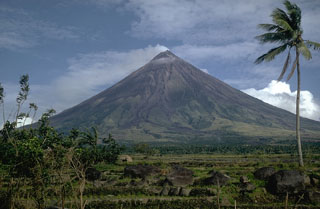Report on Mayon (Philippines) — 4 April-10 April 2018
Smithsonian Institution / US Geological Survey
Weekly Volcanic Activity Report, 4 April-10 April 2018
Managing Editor: Sally Sennert.
Please cite this report as:
Global Volcanism Program, 2018. Report on Mayon (Philippines) (Sennert, S, ed.). Weekly Volcanic Activity Report, 4 April-10 April 2018. Smithsonian Institution and US Geological Survey.
Mayon
Philippines
13.257°N, 123.685°E; summit elev. 2462 m
All times are local (unless otherwise noted)
PHIVOLCS reported that during 4-10 April white steam plumes from Mayon drifted WNW, WSW, and SW. Crater incandescence was visible at night. The sulfur dioxide flux was 899 tonnes/day on 5 April. Tiltmeter data recorded deflation since 20 February despite short-term episodes of inflation at the lower and middle flanks. Precise leveling data showed deflation during 22-29 March relative to surveys conducted during 10-19 March. Overall ground deformation data suggested inflation compared to baseline levels. The Alert Level remained at 2 (on a 0-5 scale) and PHIVOLCS reminded residents to stay away from the 6-km-radius Permanent Danger Zone and the 7-km Extended Danger Zone on the SSW and ENE flanks.
Geological Summary. Symmetrical Mayon, which rises above the Albay Gulf NW of Legazpi City, is the most active volcano of the Philippines. The steep upper slopes are capped by a small summit crater. Recorded eruptions since 1616 CE range from Strombolian to basaltic Plinian, with cyclical activity beginning with basaltic eruptions, followed by longer periods of andesitic lava flows. Eruptions occur predominately from the central conduit and have also produced lava flows that travel far down the flanks. Pyroclastic density currents and mudflows have commonly swept down many of the approximately 40 ravines that radiate from the summit and have often damaged populated lowland areas. A violent eruption in 1814 killed more than 1,200 people and devastated several towns.
Source: Philippine Institute of Volcanology and Seismology (PHIVOLCS)

